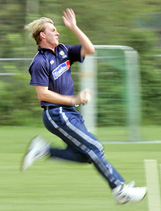COACHING
The Shoulder and its Core Stability
Sports fitness professionals have realized how critical it is for the inner core of the body, mainly the joints close to the spine, to be supported by the postural muscles designed for the same purpose. For a cricketer's shoulder joint for instance, the critical areas are the cervical spine (upper back), lumber-spine (lower back) and the scapulothoracic joint. If these areas are not stable, then a significant amount of extra load and strain will be passed onto the shoulder joint. This basically means that a cricketer with a weak lower, middle or upper back can put undue pressure on his shoulder while bowling or throwing, and in the process damage his shoulder joint.The SCAPULOTHORACIC joint is the most relevant joint for the shoulder, as the GLENOHUMERAL JOINT is formed by the glenoid cavity of the scapula (socket) and humerus (ball). The muscles directly responsible for its stability are TRAPEZIUS (muscle covering the back of the neck and upper shoulder), especially its middle and lower fibres acting with the SERATUS ANTERIOR muscle (muscle covering the under and inner part of the shoulder), and together they hold the scapula in a neutral position.

Brett Lee ready to explode
Whenever you throw or bowl, i.e. move the arm
sideways or take it above the head, the rotator
cuff muscle controls the neutral position. So the
head of the humerus is properly controlled.
It is really amazing that such a high level of balancing is achieved when we do overhead activity. It becomes more effective and controlled when the scapular position is perfect. If the scapula is angled too far (i.e: a bowler with a round-arm action moving his arm away from the midline of the body) puts a lot of pressure on the rotator cuff muscle and bio-mechanically fails to keep ahead of the humerus centred. As you improve your scapular muscle strength, lesser will be the pressure on the rotator cuff. Therefore it will be able to act more effectively and independently. So, whenever a bowler is in the act of moving his arm, he should be able to hold his scapula quite stable and in a neutral position. This skill is called GLENOHUMERAL DISSOCIATION
It is really amazing that such a high level of balancing is achieved when we do overhead activity. It becomes more effective and controlled when the scapular position is perfect. If the scapula is angled too far (i.e: a bowler with a round-arm action moving his arm away from the midline of the body) puts a lot of pressure on the rotator cuff muscle and bio-mechanically fails to keep ahead of the humerus centred. As you improve your scapular muscle strength, lesser will be the pressure on the rotator cuff. Therefore it will be able to act more effectively and independently. So, whenever a bowler is in the act of moving his arm, he should be able to hold his scapula quite stable and in a neutral position. This skill is called GLENOHUMERAL DISSOCIATION
1. INTERNAL /EXTERNAL ROTATION WITH ARM BY THE SIDE. Stand. Hold a rolled towel between the elbow and ribs. Attach one end of an elastic or theraband to a door-knob and hold the other end in your hand with elbow bent at 90 degrees. Position the scapula perfectly. Slowly pull the band across the body at the same time. Do three sets of ten pulls to the right. Do three sets of ten pulls to the left.
2. INTERNAL /EXTERNAL ROTATION WITH THE ARM 90 DEGREES AWAY FROM THE BODY. Lie on the back. Attach one end of theraband to a chair-leg and hold the other end in your hand with the elbow bent at 90 degrees and resting on the ground. Position the scapula perfectly. Pull the hand forward until you cannot pull it anymore (the limit of flexibility) Slowly release. Do three sets of ten repetitions each. Then do the same in the opposite direction, pulling the hand up above the head (Three sets of ten repetitions each).
3. FACE THE BALL (use a Swiss ball) You should face a wall. Hold the ball with your right hand facing the wall at head-height. Step back so that you are leaning on the ball Position the scapula perfectly. Create small circles on the wall with outstretched hand on the ball. Do five sets of ten repetitions clockwise and then anti-clockwise. Rest & repeat. Repeat the same with left hand.
4. TENNIS BALL WORKOUT: Squeeze a tennis ball in the hand. Go through throwing motions slowly while squeezing the ball. one has to behave as if one is making an actual throw Set scapula at outset of throw Slowly release and do an exaggerated follow-through with the entire body in motion. Repeat 10 to 20 times. This is an excellent exercise for co-contraction of rotator cuff muscles, which will help increase their activity and control the head of humerus.
5. GENTLE FLICKS Stand with the theraband attached to the door-knob. Face away from the door. How far you should stand from the door depends upon how strong you are. A person on the stronger side can stand at a distance, while one who is not so strong can stand closer.
Hold the arm up above the head with band in hand on tension Allow the arm to drop backwards slightly from elastic tension Pull forward slightly on the tension Repeat slowly and gradually increase speed and tension over the following two or three weeks.
Monitor any shoulder soreness to determine whether you have gone too far.
ALWAYS CONTINUE WITH GENERAL MUSCLE STRENGTH EXERCISES